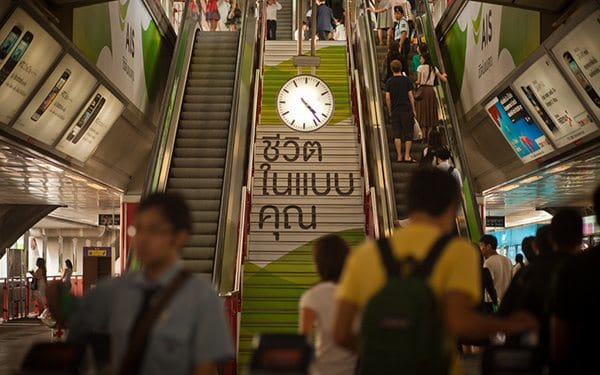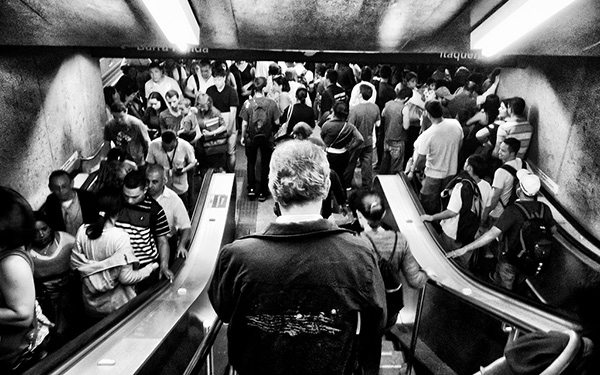Walking down a street in Bangkok is enough to fill the best of us with rage.
Between those texting rather than looking where they’re going, motorbikes on the pavement, and seemingly the majority of people simply having an utter lack of spatial awareness, getting where you want to go can be a challenge. Of course, the long-awaited release in Thailand of Pokémon Go means those of us who simply want to walk from A to B now also have to contend with trainers out to find Pikachu and friends.
But if walking around the Thai capital is infuriating, it’s got nothing on riding an escalator here.
Whether it’s on the way up to a Skytrain station, inside a shopping centre, or at the airport, it’s escalator etiquette – or rather the complete lack of it on the part of so many people in Bangkok – that really makes my blood boil.
And I know I’m not alone.
Those of us from busy world hubs like London and New York have our stand-to-one-side adherence to the escalator rulebook honed to a tee, and it all stems from one simple fact: that none of us are really standing on an escalator for the fun of it, but because we want to get somewhere.
We’re all busy people, we’ve all got things to get done, and having people inconsiderately block the way up or down only gets in the way of that.
It’s one thing in a shopping centre, when you’re probably out for a casual wander and have some time to kill behind throngs of escalator-hoggers, but it’s an entirely different kettle of fish when you’re already late for work and you just want to get up to the platform and onto the train that you already hear pulling in.
It’s not even as if Bangkok – or even Thailand more generally – has a shortage of escalators, resulting in a lack of awareness as to how to use them. There might be an especially high number in the capital, but they’re dotted around shopping centres, hotels and office buildings up and down the land.
And nor is it as if western cities like London and New York are the only ones who have the escalator thing working — city-dwellers elsewhere around the world generally have the hang of it too.
Yet still, every time you’re on the way up to a BTS platform, you inevitably find yourself stuck behind a deep-in-conversation duo straddling both sides of the escalator – or a lone troublemaker utterly oblivious to the fact that they’re the only one standing on the left-hand side while everyone else is neatly filed along the right.

By Nopphan Bunnag (www.nopphan.com | me@nopphan.com) CC BY-SA 2.0 Licence
The problem is that it really does only take that one away-with-the-fairies character to cause an entire traffic jam of frustrated commuters. Take their disregard for the desire of anyone around them to climb the escalator at a moderately faster pace, and combine it with that textbook Thai meekness that deems it culturally unthinkable to risk confrontation by asking them to stand aside, and one person blocking the pathway suddenly becomes an entire line of people silently fuming because they too want to walk through.
And because they don’t say anything to get that person out of the way, they too unwittingly end up causing even more of a blockage.
The BTS has made efforts to fix the problem – but, frankly, they were doomed from the outset.
Inconspicuous stickers placed along the bottom of the handrail on the Skytrain system’s escalators implore you to ‘stand right’ and ‘walk left’.
But here’s the problem: those two commandments aren’t displayed together.
Instead, stand in everyone’s way on the left-hand side and all you’ll see an instruction to ‘walk left’ (not to ‘stand right’) – hardly an instruction to get the hell over the other side, and probably ambiguous enough to lead the oblivious to believe they’re already following the rules.
Likewise, when you’re on the right, you’re only told to ‘stand right’ – which, if you can see that sticker, you’re likely already doing. That’s what I call a design flaw.
Needless to say, the kind of people who stand on the wrong side of the escalator (or worse still spread themselves across both sides) are unlikely to pay much attention to these signs in the first place, and in truth they have little impact.
The situation is made only more challenging by the MRT subway’s more recent decision to implore people not to walk at all – seemingly in response to various accidents involving escalators around the world. As a result, stickers on the escalators themselves encourage commuters to stand still, and announcements played in stations call on us all to do the same – as if the get-in-everybody’s-way brigade needed any more encouragement.
Thankfully, those keen on the streamlined flow of people – apparently we’re in the minority – seem to be paying scant attention to these notices, and there’s still some rebellious walking happening on those MRT escalators (if anything, you see more movement there than on the BTS – excepting that hideous, forever-clogged mini-escalator between the BTS and MRT at Asok!)
That can only be a good thing – because, call me reckless, but I’m of the totally-non-expert view that escalator accidents tend to happen as a result of poor maintenance rather than people walking (else, where were all the collapsing escalators in the decades the rest of us were merrily walking up and down them elsewhere in the world?).
In spite of that, traffic flow on Bangkok’s escalators isn’t going anywhere fast. For now, it looks like passive-aggressive huffing and puffing at those blocking our way is here to stay.
Featured image is by Diego Torres Silvestre and used under a CC BY 2.0 licence


